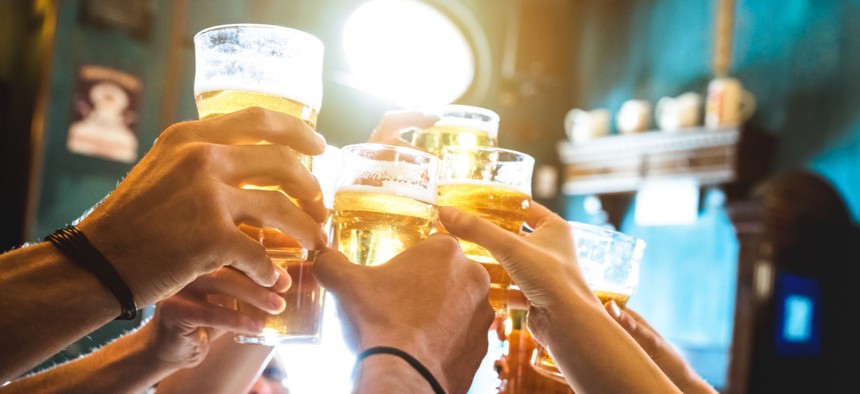Has the Rise of Uber Led to More Heavy Drinking?

View Apart/Shutterstock.com
New research suggests that ride-hailing is associated with increases in drinking behaviors in U.S. cities and metro areas.
If I am going out and plan to have just one drink, I’ll call an Uber. And that’s a good thing: Drunk driving is a public-health crisis, killing more than 10,000 people a year. One advantage of ride-hailing services like Uber and Lyft is that, according to a number of studies, they reduce drunk driving.
But there’s another connection between ride-hailing and alcohol. Ordering that Uber, it seems, encourages people to drink more than they otherwise would.
That’s the big takeaway of a newly published study by a team of economists: Jacob Burgdorf and Conor Lennon of the University of Louisville and Keith Teltser of Georgia State University. Their study tracks the connection effects of ride-hailing services and drinking behavior across U.S. cities and metropolitan areas.
Previous research has found that the introduction of Uber’s ride-hailing service was associated with a 10 percent decrease in overall fatal crashes involving alcohol; a 10 percent decrease in drunk-driving arrests in Seattle (according to an analysis by Uber and Mothers Against Drunk Driving); and a 25 to 35 percent decline in booze-related crashes in four New York City boroughs. (However, other research has challenged such findings.)
Meanwhile, studies have found that alternatives to driving can lead to increased drinking. Indeed, one found peak use of Uber ride-hailing to be correlated with bar closing times in cities like Chicago, Pittsburgh, and Miami.
The hypothesis here is that when people have to drive themselves, they drink less, or identify a designated driver, and that reduces overall drinking levels in a city or metro area. But once the alternative of ride-hailing is available, a constraint is removed, leading to a local increase in both the frequency and quantity of alcohol consumption and in other risky behaviors.
The study uses detailed data on UberX, Uber’s most used ride-hailing service—data that was organized for an earlier study of the effect of Uber on public transit (which CityLab’s Sarah Holder wrote about here). It allows the researchers to identify exactly when Uber entered a city or metro and to look at the effect of its entry on drinking. As the researchers note, UberX entered New York City in the summer of 2012, and by the end of 2013 was up and running in 34 U.S. metros, expanding to 150 by the end of 2014, and more than 200 by the end of 2016.
The study also uses data on alcohol consumption and drinking behavior from the CDC’s Behavioral Risk Factor Surveillance System for the period 2009 to 2016. The CDC’s survey covers more than 400,000 people across the country and includes several detailed questions about the quantity and frequency of people’s alcohol consumption.
The researchers look at the effect of ride-hailing on overall drinking patterns in metro areas, not individual drinking behavior. They take great care to control for various demographic and economic factors, like age and income, that affect drinking rates across cities and metro areas.
Ride-hailing is associated with significant increases across a wide range of drinking behaviors, they find. The average number of drinks people consume per day: up more than 3 percent. The number of days when people drink: up almost 3 percent. The maximum number of drinks consumed at any one occasion: up nearly 5 percent. Heavy drinking: up 9 percent. The data may underestimate the “true effect” of Uber on binge and heavy drinking, the researchers note.
In addition to more drinking, ride-hailing is associated with a roughly 2.5 percent increase in employment and wages at drinking establishments.
The connection is even more pronounced in larger metros and in metros that were served by Uber early on. And ride-hailing leads to considerably larger increases in drinking in cities and metros with weak public-transit systems. In these places, the researchers find UberX to be associated with a roughly 20 percent increase in binge drinking.
The logic is simple: If drinkers do not have to drive and can depend on calling a ride, many will drink more, and some will drink a whole lot more. Ride-hailing can reduce drunk driving, and that’s a big benefit. But it increases excessive drinking, and that leads to other dangerous behaviors and outcomes, like fights, risky sexual behavior, falls, and illness. In any given year, almost 90,000 people die from excessive drinking—roughly nine times as many as the 10,500 or so who are killed by drunk drivers.
As the researchers observe, their findings “imply that the net social impact of ridesharing is more complicated than the existing literature and policy debates suggest.”





